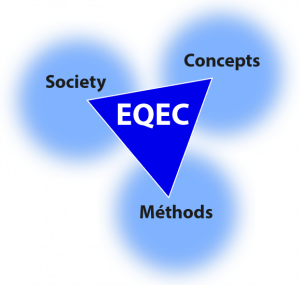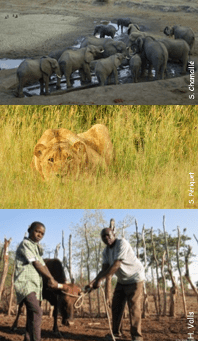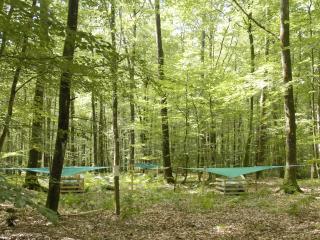Quantitative and Evolutionary Ecology of Communities Group
Members

Doctorante
UCBL

Professeure des universités
VetAgro-Sup
Tel: 33 04 72 43 27 56

Directeur de recherche
CNRS
Tel: 33 04 72 43 27 57

Doctorant
UCBL
Tel: 04 72 44 81 42

Doctorant
CNRS
Tel: 04 72 44 81 42
Doctorant
VetAgro-Sup

Maître de conférences
UCBL
Tel: 04 72 44 81 42
Doctorant
UCBL


Professeur des universités
UCBL
Tel: 33 04 72 43 27 56

Professeur des universités
UCBL

Directeur de recherche
CNRS
Tel: 33 04 72 43 27 56

Maîtresse de conférences
UCBL
Tel: 33 04 72 43 29 02
Maître de conférences
UCBL
Tel: 33 04 72 43 29 02

Our research activities, focused on interspecific interactions (community ecology), aim to better understand the ecological and evolutionary processes structuring species assemblages and biodiversity at different temporal and spatial scales. Our team addresses these major issues using contrasting biological models (communities of large African mammals, insects, microbiota, plants) from 3 complementary angles:
- Our work is strongly anchored in the conceptual framework of evolutionary biology by studying (i) the diversity of adaptive responses implemented by organisms to selective pressures in their environment, (ii) their consequences on population demography and ultimately (iii) the dynamics and composition of species communities.
- Our research is closely linked to societal issues of biodiversity conservation and management by integrating both the functioning of socio-ecological systems and the context of climate change. We conduct experimental studies, manage and ensure the long-term monitoring of several community observation networks.
- Methodological issues also occupy a central place in our team, with the development of new tools for statistical processing and modeling of ecological data. This activity leads to the development of methods and software that we develop and distribute freely.
Research programs

Functioning of African savanna communities
The Hwange LTSER (Long-Term Socio-Ecological Research site in Zimbabwe hosts a long-term interdisciplinary research program that focuses on the functioning of plant and animal communities within the Hwange National Park and the interactions between this protected area and humans living in its periphery. Based on this program, three axes are developed: (1) studying the population dynamics of elephants, exploring their impact and that of management policies on the socio-ecosystem functioning; (2) Understanding the extent to which interactions within and between trophic levels are sensitive to management actions (e.g. sport hunting, water management) and climate change; (3) Decoding human ecology and human-wildlife coexistence mechanisms towards integrated conservation and sustainable functioning of the socio-ecosystem. This research is complemented by more recent works in the Hluhluwe-iMfolozi Park and in the Madikwe reserve in South Africa, which focus on the role of environmental conditions on the hunting success of large African carnivores. We work in close collaboration with the IRL (International Research Lab) Rehabs.
Involved group members : Alice Bernard, Laura Lacomme, Aïssa Morin, Lisa Nicvert, Elie Pedarros, Yolan Richard, Marion Valeix*

Masting and the community dynamics of seed consumers
Masting is a reproductive strategy often encountered in perennial plants, characterized by fructifications highly fluctuating in time and being synchronized at the population level. The seeds produced that way constitute a pulsed resource with a strong impact on the eco-evolutionary dynamics of seed-consuming communities and forest regeneration. Our lack of knowledge of this system still impedes our understanding of the dynamics of temperate forest ecosystems and its future in the context of climate change. Our work carried out on oak forests aims to better understand (i) the proximal causes of masting, (ii) the mechanisms underlying the coexistence of species competing for such highly fluctuating resource and (iii) the co-evolution of consumer exploitation strategies for the fluctuating resource and forest tree fruiting strategies. On the basis of the results obtained, scenarii will be proposed on the future of forest regeneration under climate change, that may serve forest management.
Involved group members : Marie-Claude Bel-Venner*, Emilie Fleurot, Léa Keurinck, Jean Lobry, Samuel Venner

The spread of antibiotic resistance genes in bacteria
Antibiotic resistance is recognized as one of the greatest current threats to human health, and the mobile genetic elements (MGEs) that circulate in bacterial populations and communities are the main vehicles. To understand the dynamics and diversity of MGEs in bacterial pangenomes and the emergence of antibiotic resistance genes, we propose to go beyond the framework of conventional genomics by considering pangenomes as complex ecological communities. In the Ab-One program, we mobilize the concepts and tools developed in community ecology based on an integrative approach (monitoring of bacterial populations/communities evolving in contrasting environments -One-Health approaches-, pan-genomic analyses, experimentation in molecular and cellular microbiology, mathematical modelling). This program is currently focused on the dynamics of MGEs in Acinetobacter baumannii, an antibiotic-resistant microorganism classified as a priority by the WHO. Other more general approaches will illustrate the relevance of this new conceptual framework to understand the dynamics and diversity of MGEs in bacterial pangenomes. This program, co-piloted by our team and a team from CIRI (Horigene) involves the participation of 9 organizations (6 from Lyon -LBBE, CIRI, MMSB, HCL, LEM, VetAgro Sup-, Institut Pasteur (Paris), LMGM (Toulouse ), Robert Koch Institute (Germany)).
Involved group members : Stéphane Dray, Rémi Tuffet, Samuel Venner*

Statistical analysis of ecological data
Understanding the structure and dynamics of species assemblages, and the processes behind them, requires collecting data that are becoming increasingly complex owing to the sophisticated technological developments made available for their acquisition (e.g. GPS, loggers, satellite imagery, molecular data). We are developing new methods for analysing such data, that provide new insights into the ecological processes at work in communities. Multivariate analysis methods allow the analysis of spatial structures, accounting for various information on species (functional traits, morphology, phylogeny), the spatio-temporal variation of species-environment relationships or the multifaceted perception of the protected human-environment relationship. We also model multi-'omics' dose-response data within communities in order to better understand the Adverse Outcome Pathway (AOP) and to better appreciate the risks to the environment. These methodological innovations are made available to the scientific community through the development, distribution and maintenance of software (libraries for the R language: ade4, adegraphics, adephylo, ade4TkGUI, nlstools, fitdistrplus, DRomics, seqinr).
Involved group members: Marie Laure Delignette-Muller, Stéphane Dray*, Jean Lobry, Jean Thioulouse.
Publications
Display of 421 to 450 publications on 656 in total
Controlled ectomycorrhization of an exotic legume tree species Acacia holosericea affects the structure of root nodule bacteria community and their symbiotic effectiveness on Faidherbia albida a native Sahelian Acacia
Soil Biology and Biochemistry . 41(6) : 1245-1252
Journal article
see the publicationBiogeographical patterns of soil bacterial communities
Environmental Microbiology Reports . 1 ( 4 ) : 251 - 255
Journal article
see the publicationMonitoring the Development of Nurse Plant Species to Improve the Performances of Reforestation Programs in Mediterranean Areas
incollection . -- : 443-450
Journal article
see the publicationAphylogenomic analysis of bacterial helix^turn^helix transcription factors
FEMS Microbiology Reviews . 33 : 411-429
Journal article
see the publicationDEBtox theory and matrix population models as helpful tools in understanding the interaction between toxic cyanobacteria and zooplankton
Journal of Theoretical Biology . 258 : 380-388
Journal article
see the publicationPatterns biogéographiques de la diversité bactérienne des sols à l'échelle du territoire national
Congrès AFEM (Association Francophone pour l'Ecologie Microbienne . : n.p.
Conference paper
see the publicationMicrobial-biogeography at the scale of France by the use of molecular tools applied to the French soil quality monitoring network (RMQS)
BAGECO10 .
Conference paper
see the publicationPrédiction des propriétés du sol à l’échelle nationale à partir des données du RMQS : Exemple des Éléments Trace Métalliques
10. Journées d'Etude des Sols .
Conference paper
see the publicationDiversité des communautés microbiennes telluriques à l'échelle du territoire national
Journées d'Etude des Sols . : 151-152
Conference paper
see the publicationECOMIC-RMQS : biogéographie microbienne à l’échelle de la France. Etat d’avancement et premiers résultats
Étude et Gestion des Sols . 16 ( 3-4 ) : 219-231
Journal article
see the publicationEcophysiological attributes of adult overwintering in insects: insights from a field study of the nut weevil, Curculio nucum
Physiological Entomology . 34 : 61-70
Journal article
see the publicationLes Harttiini (Siluriformes, Loricariidae) des Guyanes : phylogénie et évolution des formes ou variation sur un même thème
4. Rencontres de l'Ichtyologie en France .
Conference paper
see the publicationDynamics of transposable elements:towards a community ecology of the genome
Trends in Genetics . 25(7) : 317-323
Journal article
see the publicationSpatially heterogeneous stochasticity and the adaptive diversification of dormancy
Journal of Evolutionary Biology . 22 : 2094-2103
Journal article
see the publicationDEBtox theory and matrix population models as helpful tools in understanding the interaction between toxic cyanobacteria and zooplankton
Journal of Theoretical Biology . 258 ( 3 ) : 380
Journal article
see the publicationReBaStaBa: handling Bayesian networks with R
The R User Conference 2009 .
Conference paper
see the publicationFitting parametric distributions using R : the fitdistrplus package
The 5th R useR conference Agrocampus Ouest . : 47
Conference paper
see the publicationQuantitative Risk Assessment of Listeria monocytogenes in French cold-smoked Salmon: II. Risk Characterization
Risk Analysis . 29 ( 6 ) : 806-819
Journal article
see the publicationFate of acid-resistant and non-acid resistant Shiga toxin-producing Escherichia coli strains in experimentally contaminated French fermented raw meat sausages
International Journal of Food Microbiology . 129(3) : 264-270
Journal article
see the publicationFinding essential scales of spatial variation in ecological data: a multivariate approach
Ecography . 32(1) : 161-168
Journal article
see the publicationThe concept of animals trajectories from a data analysis perspective
Ecological Informatics . 4 ( 1 ) : 34-41
Journal article
see the publicationResponding to spatial and temporal variations in predation risk: space use of a game species in a changing landsape of fear
Canadian Journal of Zoology . 87 : 1129-1137
DOI: 10.1139/Z09-101
Journal article
see the publicationEcomic - RMQs : Cartographie de la diversité microbienne des sols à l'échelle de la France
4ème Colloque de l'Association Francophone d'Ecologie Microbienne (AFEM) . : 1 p.
Conference paper
see the publicationEcomic - RMQs : Cartographie de la diversité microbienne des sols à l'échelle de la France
4ème Colloque de l'Association Francophone d'Ecologie Microbienne (AFEM) . : 1 p.
Conference paper
see the publicationDiversité des communautés microbiennes telluriques à l'échelle du territoire national
Journées d'Etude des Sols . : 151-152
Conference paper
see the publicationRhizosphere microbiota interfers with plant-plant interactions
Plant and Soil . ( 321 ) : 259-278
Journal article
see the publicationMultivariate analysis of the spatial patterns of 8 trace elements using the French soil monitoring network data
Science of the Total Environment . 407 : 5644-5652
Journal article
see the publicationResponses of Pinus halepensis growth soil microbial catabolic functions and phosphate-solubilizing bacteria after rock phosphate amendment and ectomycorrhizal inoculation
Plant and Soil . 320 (1-2) : 169-179
Journal article
see the publicationResponses of Pinus halepensis growth, soil microbial catabolic functions and phosphate-solubilizing bacteria after rock phosphate amendment and ectomycorrhizal inoculation.
Plant and Soil . 320 : 169-179
Journal article
see the publicationMultivariate analysis of the spatial patterns of 8 trace elements using the French soil monitoring network data
Science of the Total Environment . 407 : 5644–5652
Journal article
see the publication
You also, comment on this article